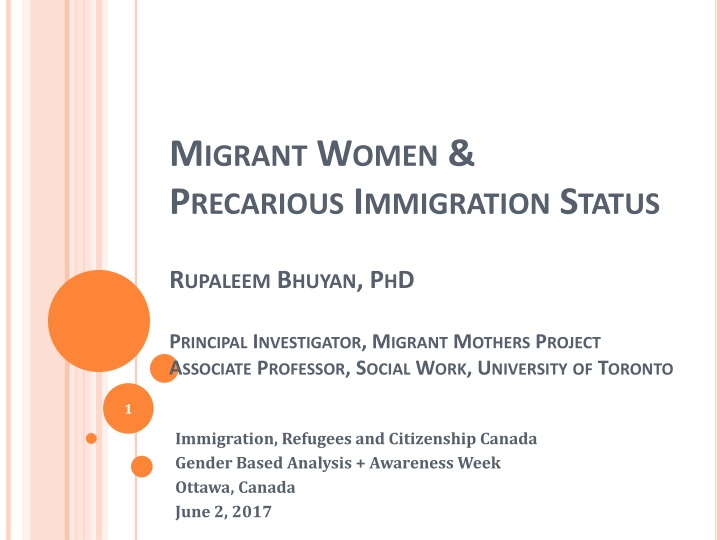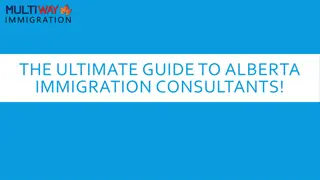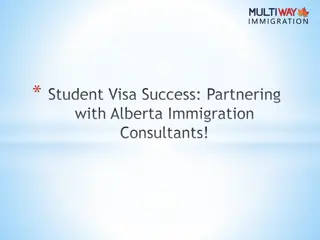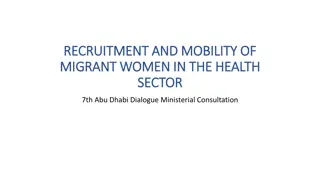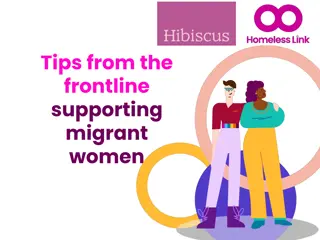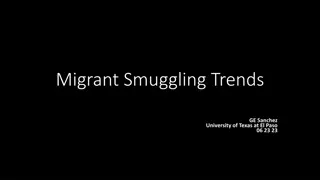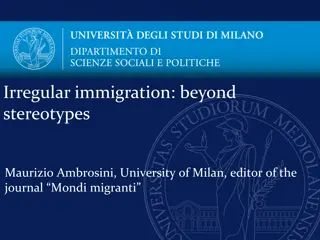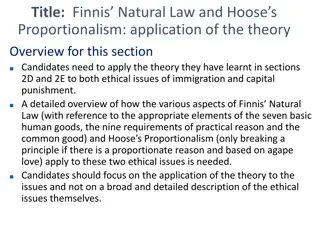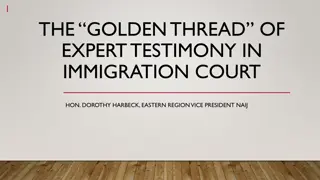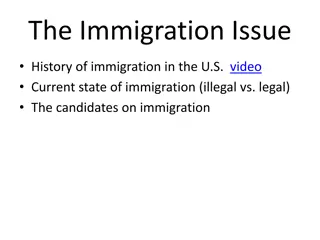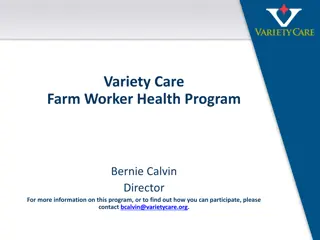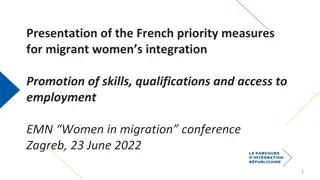Migrant Women and Precarious Immigration Status by Rupaleem Bhuyan
This presentation highlights the Migrant Mothers Project, focusing on the impact of immigration policies on women, their struggle for safety, and their efforts to access support services in Canada. Research studies delve into the challenges faced by refugee claimants, sponsored spouses, and international caregivers.
Download Presentation

Please find below an Image/Link to download the presentation.
The content on the website is provided AS IS for your information and personal use only. It may not be sold, licensed, or shared on other websites without obtaining consent from the author.If you encounter any issues during the download, it is possible that the publisher has removed the file from their server.
You are allowed to download the files provided on this website for personal or commercial use, subject to the condition that they are used lawfully. All files are the property of their respective owners.
The content on the website is provided AS IS for your information and personal use only. It may not be sold, licensed, or shared on other websites without obtaining consent from the author.
E N D
Presentation Transcript
MIGRANT WOMEN & PRECARIOUS IMMIGRATION STATUS RUPALEEM BHUYAN, PHD PRINCIPAL INVESTIGATOR, MIGRANT MOTHERS PROJECT ASSOCIATE PROFESSOR, SOCIAL WORK, UNIVERSITY OF TORONTO 1 Immigration, Refugees and Citizenship Canada Gender Based Analysis + Awareness Week Ottawa, Canada June 2, 2017
PRESENTATION AGENDA Migrant Mothers Project Canadian Context Theoretical Framework Study Foci & Key Concerns 2
MIGRANT MOTHERS PROJECT (MMP) OVERVIEW 2011 - present Funded by SSHRC, CERIS, University of Toronto Active network of service providers, legal advocates grassroots immigrant leaders and academics Community Partners: Ethno Cultural Council of Calgary South Asian Legal Clinic of Ontario Thorncliffe Neighborhood Office WomanAct Ontario Council of Agencies Serving Immigrants METRAC 3
MMP - RESEARCH, ENGAGEMENT & ADVOCACY Research Goals Understand how immigration policies produce inequalities that contribute to violence against women Explore how immigrant women negotiate rights and belonging when seeking safety and support Community Engagement & Advocacy Goals Connect research to grassroots advocacy Recommend service delivery & policy changes Build capacity among people most impacted by the research topic 4
MMP - RESEARCH STUDIES Study Foci: Refugee Claimants Sponsored Spouses & Partners International Caregivers Research Methods: Analysis of public policy, regulations, and announcements Demographic data from CIC/IRCC & IRB Interviews with stakeholders & immigrants Key Concerns Vulnerability to family or partner violence Barriers to accessing safety and support services Barriers to full citizenship 5
CANADIAN CONTEXT Steady immigration since the 1980s Average 250,000 new permanent residents/yr. Top source countries: Philippines, India & China Majority of foreign born live in Ontario, British Columbia, Quebec, and Alberta 53% of Canada s foreign born population live in Ontario (National Housing Survey, 2011) 7
POLICY TRENDS 2008-2014, most active period of policy change Family Reunification, Economic, Humanitarian & Citizenship Marked growth in temporary migration Temporary foreign workers (high skilled & low-skilled) International students New conditions on family sponsorship Fewer refugee claimants Shift to more precarious immigration Temporary migrants have limited rights Restrictions on access to permanent residence 8
GROWING IMMIGRANT POVERTY Most immigrants are highly skilled, yet underemployed or unemployed 35% poverty rate for immigrants, <5 years in Canada 10% poverty rate for the general population 9
2015: PERMANENTVS. TEMPORARY Permanent Residents Temporary Residents Category Number % Category Number % Family Class 65,395 24 Foreign Worker 331,530 36 Economic Immigrant 170,390 63 Foreign Student 459,644 50 Refugees 32,100 12 Humanitarian 32781 4 Other Immigrant 3,843 1 Other Work Permit 98144 11 TOTAL 271,728 100 TOTAL 922,099 100 Adapted from IRCC (2015) 10
IMMIGRANT WOMEN 3,544,400 immigrant women and girls in Canada (2011 National Household Survey) 21% of Canada s population 51% admitted through Economic Class 34% as spouse or dependent 34% through Family Class 9% as Refugees Trends (Hudon, 2013) The majority enter as spouses or dependents Growing proportion of principal applicant, Economic Class Most female immigrants are visible minorities 60.6% of immigrant females vs. 19.3% of total female population 11
THEORETICAL FRAMEWORK Illegalized vs. Illegal Immigrant Precarious Immigration Status Structurally Embedded Borders Intersectionality 12
CASE STUDY: MEXICAN REFUGEE CLAIMS RELATEDTO DOMESTIC VIOLENCE 2007-2012 14
VIOLENCEAGAINST WOMENIN MEXICO Rates of violence in Mexico: 43.2% of women 15 years of older have been victims of intimate partner violence (emotional, financial, physical or sexual) (ONU, INEGI, 2009) 36,606 femicides from 1985 - 2010 50,000 deaths from 2006-2012 due to drug war (Taylor, 2012) Mexican Laws 2006 General Law for the Equality between Men and Women 2007 General Law on Women s Access to a Life Free of Violence, revisions in 2009 and 2014 30 out of 32 states have criminalized violence against women 15
Mexican Asylum/Refugee Claims Filed During the Year, 2000-2014 (UNHCR, 2015) CANADA USA TOTAL 46,355 125,927 % 27% 72.8% Recognized Mexican Refugee Claims, 2000-2014 (UNHCR, 2015) CANADA USA OTHER TOTAL 7,777 3,487 46 % 70% 29.6% 0.4% 16
MEXICAN REFUGEE CLAIMANTS, PRINCIPAL APPLICANTS ONLY, 2007-2012 (IRB, 2012) Outcomes - Females Gender Breakdown 4,897 (31%) 1,310 (27%) 2,758 (56%) 11,131 (69%) 819 (17%) Positive Negative Withdrawn or Abandoned Female Male 17 Total number of Claims: 16,028
DOMESTIC VIOLENCEAS BASISOF INITIAL CLAIM 2008-2012 (IRB, 2012) YEAR MALE FEMALE POSITIVE NEGATIVE OTHER DEPENDENTS TOTAL 28 567 152 316 127 377 % 4.7 95.3 26 53 21 -- 10% of female refugee claimants report DV as basis of initial claim, 2008-2012 In 2009, IRB reported that 7% of all claims were gender-related. Majority denied for inability to prove lack of state protection 18
GENDER BASED ANALYSISIN PRACTICE Legal hurdles for recognizing gender persecution (Mawani, 1993) Persecution against women is often informal, intimate, and indirect Internal flight alternative presumes women are equally mobile Evidentiary requirements presume women have access to justice Refugee receiving vs. refugee producing countries Uneven response to barbaric vs. universal violence Backlash to feminism and equity agenda (Sadoway, 2008) Cursory attention to Guidelines for gender-based violence IRB accepts domestic violence laws as constituting state protection Appeal process does not assess how the gender guidelines are used 19
CASE STUDY: REGULATING TRANSNATIONAL MARRIAGE THROUGH CANADA S MULTIPLE BORDER STRATEGY 20 2012-2017
CONDITIONAL PERMANENT RESIDENCE (2012-2017) Introduced in October 2012 as part of Federal Government s crackdown on marriage fraud Two-year condition for sponsored spouses/partners who: Are in a relationship for two years or less Do not have children in common Conditions Must cohabitate in a conjugal relationship for two years May lose permanent resident status if the condition is not met, or if relationship ends Exceptions Death of sponsor Abuse or neglect REPEALED in April 2017 21
INTERNATIONAL MARRIAGES & CANADA S MULTIPLE BORDER STRATEGY Pre-Immigration Post-Immigration Sponsorship application & interview to prove authentic relationship Criminal background check Polygamy ban Visa requirement for entering Canada Border control at ports of entry Conditional PR (2-yrs) Sponsorship Ban (5 yrs) Misrepresentation Undertaking (3 yrs) Criminal inadmissibility Polygamy and inadmissibility 22
STATISTICAL PROFILEFOR SPONSORED SPOUSES (2013 2015) 58 218 newly sponsored spouses, common law partners, conjugal partners and children received CPR (Government of Canada, 2016) 42% of all spouses, partners and children in the family reunification program 63% CPR sponsored spouses were female Top 5 countries, with highest volume with CPR: India, China, Philippines, USA, Morocco Top 5 countries, highest proportion with CPR Turkey, Tunisia, Azerbaijan, Algeria, Nepal, Morocco, Cuba Average of 51%-56% received CPR 23
IMPACTSOF CONDITIONAL PERMANENT RESIDENCE Applying for exception for abuse and neglect was inconsistent Many feared consequences of reporting to CIC/IRCC Women with children who have conditional PR Service providers report that women are remaining with abusive partners, for fear of losing status Fear of reporting abuse to police related to fear of deportation Cases of marriage breakdown After arriving in Canada, sponsored immigrant learns that spouse/partner has a new relationship Both spouses/partners amicably separate Cases were Exception for Abuse & Neglect was denied because violence was not severe enough CIC officers interviewed spouse and family members, increasing risk to women seeking protection 24
LESSONSFROM CPR IMPLEMENTATION Facially neutral construction of sponsored spouse masks racialized and gendered effects Compound effect of pre- and post- migration controls Reinforces policing of racialized/Muslim immigrants as suspicious of criminal intent Enables racial and gender discrimination Unclear role for IRCC to provide protection to people abused by their sponsor: Parents & grandparents Spouse/Partner Children Temporary Foreign Worker 25
MMP POLICY RECOMMENDATIONS Repeal conditional PR and remove condition on those who received it since 2012 ACHIEVED! 1) Offer waiver for in-land sponsored spouses/partners who are abused by their sponsor; to secure a pathway to permanent residence 2) Waive 5 year ban and undertaking requirement in cases of abuse and neglect 3) Reduce processing times for in-land and overseas sponsored spouses & partners 4) Permanently extend work authorization to in-land sponsored spouses/partners who are waiting for their application to be processed. 5) 26
MMP POLICY RECOMMENDATIONS Introduce privacy protections for victims of crime who report domestic violence or trafficking to police 6) Reduce application fees for permanent residence and citizenship 7) Remove Mexico from the Safe Country list 8) Require gender based guidelines to be applied substantially to all refugee decisions 9) 10) Extend open work permits to temporary foreign workers 11) Promote national immigration strategy/ sanctuary on so that immigrants who face abuse or neglect may access essential services 27
MIGRANT MOTHERS PROJECT Unprotected, Unrecognized: Canadian Immigration Policy and Violence Against Women, 2008-2013 Til Immigrations Tears Us Apart: Stories of Strength through Struggle Principal Investigator Rupaleem Bhuyan, PhD Associate Professor Factor-Inwentash Faculty of Social Work University of Toronto r.bhuyan@utoronto.ca 28 Project Website: http://migrantmothersproject.com Find us on Facebook MigrantMothersProject
REFERENCES Bhuyan, R., & Smith-Carrier, T. (2012). Constructions of migrant rights in Canada: Is subnational citizenship possible?. Citizenship Studies, 16(2), 203-221. Bhuyan, R., Osborne, B. J., & Cruz, J. F. J. (2016). Once You Arrive, Se Te Sala Todo (Everything is Salted): Latina Migrants' Search for Dignity and a Right to Life in Canada. Journal of Immigrant & Refugee Studies, 14(4), 411-431. Goldring, L. & Landolt, P., eds. 2013. Producing and Negotiating NonCitizenship: Precarious Legal Status in Canada. Toronto: University of Toronto Press. Government of Canada (2016). Regulations Amending the Immigration and Refugee Protection Regulations. Canada Gazette, Vol. 150. Available at Hudon, T. (2013). Immigrant Women [webpage]. Statistics Canada, Government of Canada, Ottawa. Available at http://www.statcan.gc.ca/pub/89-503- x/2015001/article/14217-eng.htm#n8 Immigrants, Refugees and Citizenship Canada (2015). Facts and Figures: Immigration Overview (2015). Permanent and temporary residents. Government of Canada, Ottawa. Available at http://www.cic.gc.ca/english/resources/statistics/menu-fact.asp 29
REFERENCES (CONTINUED) Mawani, N. (1993). The factual and legal legitimacy of addressing gender issues. Refuge, 13(4). Mitchel, E. (2013). I am a woman and a human: a Marxist feminist critique of intersectionality theory. The Charnal House. Available at https://thecharnelhouse.org/tag/eve-mitchell/ Nyers, P. 2010. No One is Illegal between City and Nation . Studies in Social Justice 4(2): 127-143. Sadoway, G. (2008). The gender factor in refugee determination and the effect of "gender guidelines". In M. Hajdukowski-Ahmed, I. Khanlou, & H. Moussa (Eds.), Not born a refugee woman (pp. 244-253). New York, Oxford: Berghahn Books. Statistics Canada (2011). Immigration and ethnocultural diversity in Canada. Government of Canada, Ottawa. Available at http://www12.statcan.gc.ca/nhs- enm/2011/as-sa/99-010-x/99-010-x2011001-eng.cfm 30
